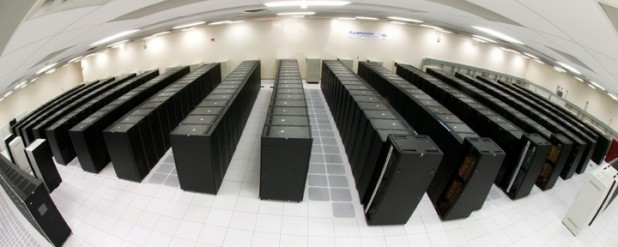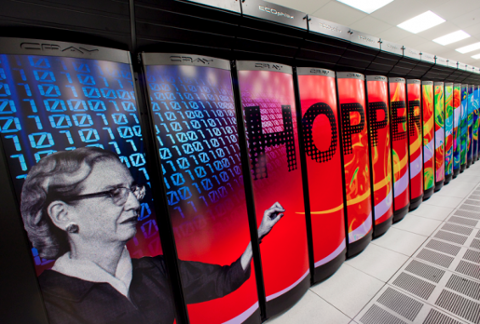 This past weekend, Los Alamos National Laboratory (LANL) decommissioned Roadroader, the first petaflop supercomputer. It was only five short years ago that the machine took the crown as the world’s fastest. Roadrunner was switched off March 31. But in the month or so between its shutdown and actual dismantlement, LANL plans on performing experiments on operating-system memory compression techniques, as well as optimized data routing, in order to help guide the design of future clustered computers. The problem? Cost, both of electricity and storage. Although Roadrunner still ranks among the top 25 most powerful systems in the world, LANL said that future solutions will need "to improve on Roadrunner’s energy efficiency to make the power bill affordable," plus require new solutions for handling and storing the vast amount of data produced on a regular basis. Once fourth on the Green500 list of the most energy-efficient supercomputers, the system had since fallen to 148th in the most recent tally, with smaller, less powerful supercomputers such as "Moonlight" and "Luna" replacing it. Cielo, also a petaflop supercomputer Los Alamos, has replaced Roadrunner at Los Alamos. Unfortunately, Roadrunner hasn’t been the only supercomputer in New Mexico facing a shutdown. The Encanto supercomputer, once the third most powerful in the world, was slated to be sold for parts in January—for very similar reasons: "We had a number of inquiries (from potential buyers), but none panned out because of how much it would cost to run the thing,” Darryl Ackley, the state’s Information Technology Secretary, told the Albuquerque Journal at the time. Roadrunner's purpose was "stockpile stewardship," or modeling the decay of the U.S. arsenal of nuclear weapons, without the need for underground testing. Related research included modeling the energy flow of a weapon, and its relationship to its yield—as well as nanowire material behavior, magnetic reconnection, laser backscatter, HIV phylogenetics, and a simulation of the universe at a 70-billion-particle scale. "What Roadrunner did was exactly what it was intended to do: get the weapons codes moving toward new architectures," Cheryl Wampler, a spokeswoman for the Weapons Physics directorate, wrote in a statement. "Roadrunner was challenging because the supercomputing future was challenging." Roadrunner was unique at the time because of its hybrid architecture, which combined CPUs and specialized graphics processors to improve its computational ability. The manufacturer, IBM, attached 1.8-GHz AMD Opterons to an IBM PowerXCell 8i, based on technology used in the Cell chip used to power the PlayStation 3 game console (the republic of Jordan recently did much the same thing.) Roadrunner used 6,563 Opteron processors, each linked to a PowerXCell. Today, combining CPUs and GPUs is much more common. Unfortunately for both the LANL and the operators of the "Encanto" supercomputer, computational power doesn't come without a cost for electrical power. And that's the primary reason for pulling the plug. Image: Los Alamos National Laboratory
This past weekend, Los Alamos National Laboratory (LANL) decommissioned Roadroader, the first petaflop supercomputer. It was only five short years ago that the machine took the crown as the world’s fastest. Roadrunner was switched off March 31. But in the month or so between its shutdown and actual dismantlement, LANL plans on performing experiments on operating-system memory compression techniques, as well as optimized data routing, in order to help guide the design of future clustered computers. The problem? Cost, both of electricity and storage. Although Roadrunner still ranks among the top 25 most powerful systems in the world, LANL said that future solutions will need "to improve on Roadrunner’s energy efficiency to make the power bill affordable," plus require new solutions for handling and storing the vast amount of data produced on a regular basis. Once fourth on the Green500 list of the most energy-efficient supercomputers, the system had since fallen to 148th in the most recent tally, with smaller, less powerful supercomputers such as "Moonlight" and "Luna" replacing it. Cielo, also a petaflop supercomputer Los Alamos, has replaced Roadrunner at Los Alamos. Unfortunately, Roadrunner hasn’t been the only supercomputer in New Mexico facing a shutdown. The Encanto supercomputer, once the third most powerful in the world, was slated to be sold for parts in January—for very similar reasons: "We had a number of inquiries (from potential buyers), but none panned out because of how much it would cost to run the thing,” Darryl Ackley, the state’s Information Technology Secretary, told the Albuquerque Journal at the time. Roadrunner's purpose was "stockpile stewardship," or modeling the decay of the U.S. arsenal of nuclear weapons, without the need for underground testing. Related research included modeling the energy flow of a weapon, and its relationship to its yield—as well as nanowire material behavior, magnetic reconnection, laser backscatter, HIV phylogenetics, and a simulation of the universe at a 70-billion-particle scale. "What Roadrunner did was exactly what it was intended to do: get the weapons codes moving toward new architectures," Cheryl Wampler, a spokeswoman for the Weapons Physics directorate, wrote in a statement. "Roadrunner was challenging because the supercomputing future was challenging." Roadrunner was unique at the time because of its hybrid architecture, which combined CPUs and specialized graphics processors to improve its computational ability. The manufacturer, IBM, attached 1.8-GHz AMD Opterons to an IBM PowerXCell 8i, based on technology used in the Cell chip used to power the PlayStation 3 game console (the republic of Jordan recently did much the same thing.) Roadrunner used 6,563 Opteron processors, each linked to a PowerXCell. Today, combining CPUs and GPUs is much more common. Unfortunately for both the LANL and the operators of the "Encanto" supercomputer, computational power doesn't come without a cost for electrical power. And that's the primary reason for pulling the plug. Image: Los Alamos National Laboratory World's First Petaflop Supercomputer, "Roadrunner," Retired
 This past weekend, Los Alamos National Laboratory (LANL) decommissioned Roadroader, the first petaflop supercomputer. It was only five short years ago that the machine took the crown as the world’s fastest. Roadrunner was switched off March 31. But in the month or so between its shutdown and actual dismantlement, LANL plans on performing experiments on operating-system memory compression techniques, as well as optimized data routing, in order to help guide the design of future clustered computers. The problem? Cost, both of electricity and storage. Although Roadrunner still ranks among the top 25 most powerful systems in the world, LANL said that future solutions will need "to improve on Roadrunner’s energy efficiency to make the power bill affordable," plus require new solutions for handling and storing the vast amount of data produced on a regular basis. Once fourth on the Green500 list of the most energy-efficient supercomputers, the system had since fallen to 148th in the most recent tally, with smaller, less powerful supercomputers such as "Moonlight" and "Luna" replacing it. Cielo, also a petaflop supercomputer Los Alamos, has replaced Roadrunner at Los Alamos. Unfortunately, Roadrunner hasn’t been the only supercomputer in New Mexico facing a shutdown. The Encanto supercomputer, once the third most powerful in the world, was slated to be sold for parts in January—for very similar reasons: "We had a number of inquiries (from potential buyers), but none panned out because of how much it would cost to run the thing,” Darryl Ackley, the state’s Information Technology Secretary, told the Albuquerque Journal at the time. Roadrunner's purpose was "stockpile stewardship," or modeling the decay of the U.S. arsenal of nuclear weapons, without the need for underground testing. Related research included modeling the energy flow of a weapon, and its relationship to its yield—as well as nanowire material behavior, magnetic reconnection, laser backscatter, HIV phylogenetics, and a simulation of the universe at a 70-billion-particle scale. "What Roadrunner did was exactly what it was intended to do: get the weapons codes moving toward new architectures," Cheryl Wampler, a spokeswoman for the Weapons Physics directorate, wrote in a statement. "Roadrunner was challenging because the supercomputing future was challenging." Roadrunner was unique at the time because of its hybrid architecture, which combined CPUs and specialized graphics processors to improve its computational ability. The manufacturer, IBM, attached 1.8-GHz AMD Opterons to an IBM PowerXCell 8i, based on technology used in the Cell chip used to power the PlayStation 3 game console (the republic of Jordan recently did much the same thing.) Roadrunner used 6,563 Opteron processors, each linked to a PowerXCell. Today, combining CPUs and GPUs is much more common. Unfortunately for both the LANL and the operators of the "Encanto" supercomputer, computational power doesn't come without a cost for electrical power. And that's the primary reason for pulling the plug. Image: Los Alamos National Laboratory
This past weekend, Los Alamos National Laboratory (LANL) decommissioned Roadroader, the first petaflop supercomputer. It was only five short years ago that the machine took the crown as the world’s fastest. Roadrunner was switched off March 31. But in the month or so between its shutdown and actual dismantlement, LANL plans on performing experiments on operating-system memory compression techniques, as well as optimized data routing, in order to help guide the design of future clustered computers. The problem? Cost, both of electricity and storage. Although Roadrunner still ranks among the top 25 most powerful systems in the world, LANL said that future solutions will need "to improve on Roadrunner’s energy efficiency to make the power bill affordable," plus require new solutions for handling and storing the vast amount of data produced on a regular basis. Once fourth on the Green500 list of the most energy-efficient supercomputers, the system had since fallen to 148th in the most recent tally, with smaller, less powerful supercomputers such as "Moonlight" and "Luna" replacing it. Cielo, also a petaflop supercomputer Los Alamos, has replaced Roadrunner at Los Alamos. Unfortunately, Roadrunner hasn’t been the only supercomputer in New Mexico facing a shutdown. The Encanto supercomputer, once the third most powerful in the world, was slated to be sold for parts in January—for very similar reasons: "We had a number of inquiries (from potential buyers), but none panned out because of how much it would cost to run the thing,” Darryl Ackley, the state’s Information Technology Secretary, told the Albuquerque Journal at the time. Roadrunner's purpose was "stockpile stewardship," or modeling the decay of the U.S. arsenal of nuclear weapons, without the need for underground testing. Related research included modeling the energy flow of a weapon, and its relationship to its yield—as well as nanowire material behavior, magnetic reconnection, laser backscatter, HIV phylogenetics, and a simulation of the universe at a 70-billion-particle scale. "What Roadrunner did was exactly what it was intended to do: get the weapons codes moving toward new architectures," Cheryl Wampler, a spokeswoman for the Weapons Physics directorate, wrote in a statement. "Roadrunner was challenging because the supercomputing future was challenging." Roadrunner was unique at the time because of its hybrid architecture, which combined CPUs and specialized graphics processors to improve its computational ability. The manufacturer, IBM, attached 1.8-GHz AMD Opterons to an IBM PowerXCell 8i, based on technology used in the Cell chip used to power the PlayStation 3 game console (the republic of Jordan recently did much the same thing.) Roadrunner used 6,563 Opteron processors, each linked to a PowerXCell. Today, combining CPUs and GPUs is much more common. Unfortunately for both the LANL and the operators of the "Encanto" supercomputer, computational power doesn't come without a cost for electrical power. And that's the primary reason for pulling the plug. Image: Los Alamos National Laboratory 
